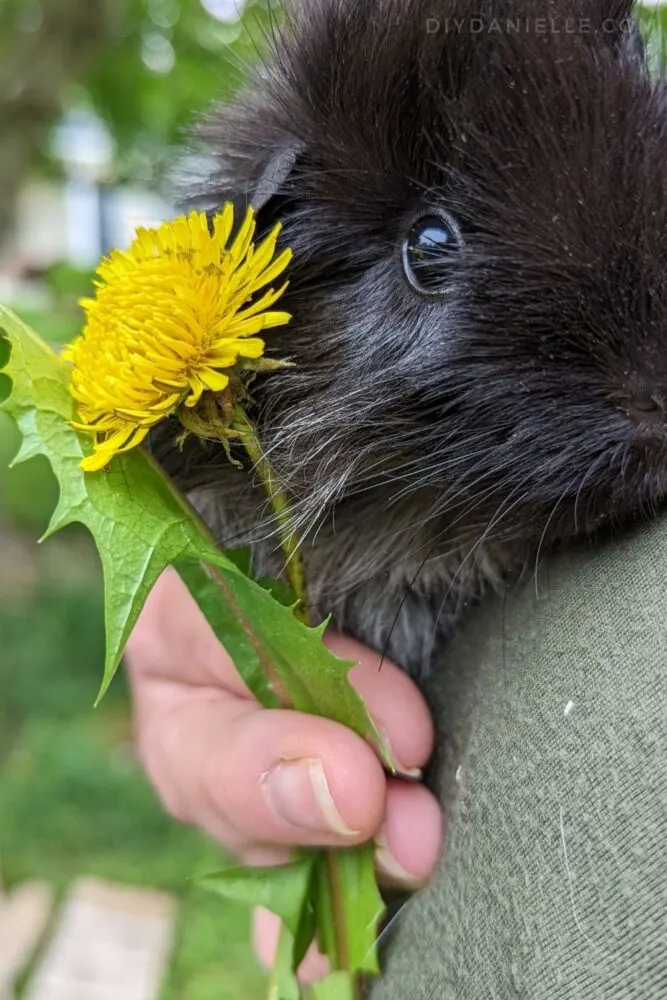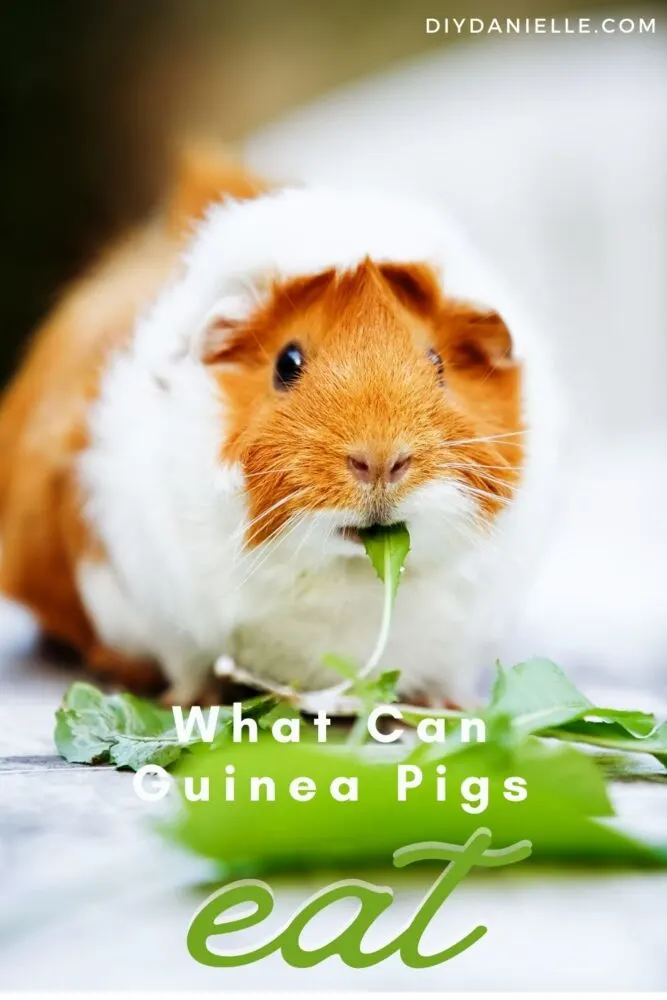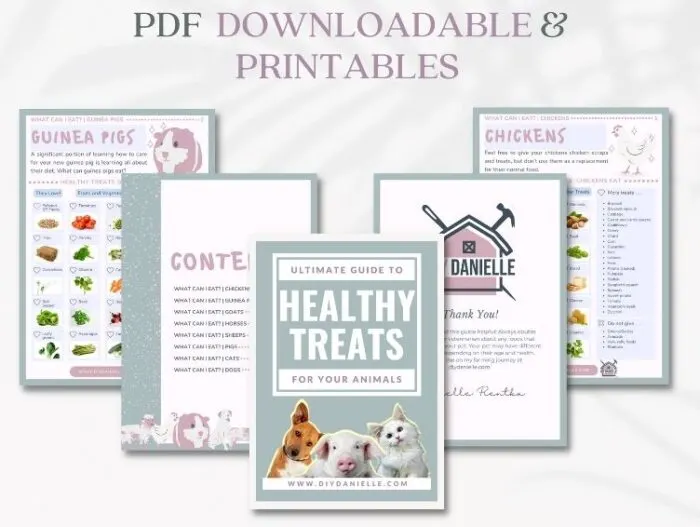So, you’re considering becoming a guinea pig owner! Or maybe you’re already on your way home with a box on your lap containing pine shavings and a curious little cavy. You’re both anxious and excited to start this new chapter of your lives together, and maybe also a little overwhelmed about all the things you have to learn to make sure your new companion thrives.
A significant portion of learning how to care for your new guinea pig is learning all about their diet. What can guinea pigs eat? What can’t they eat? How much should they eat, and how often? These questions can seem burdensome but the answers are more simple than they seem. Once you’ve learned the fundamentals, applying them to your guinea pig’s diet is a snap.
This post may contain affiliate links which may earn me commissions should you click through them and take certain actions. As an affiliate for Amazon, Cricut, xTool, Home Depot, and other sites, I earn from qualifying purchases. Please DIY carefully. View my full legal disclosures here.
Please read the whole post so you don’t miss any important information!
Whether you’re doing research in anticipation of a new pet or you’re currently a beginner pig parent, this list will help you determine the basics of what’s safe to feed your guinea. Keep reading to find out what guinea pigs can eat and what foods you should definitely avoid.
What Guinea Pigs Can Eat
Pelleted Guinea Pig Food
Well, duh, you might be saying to yourself, of course guinea pig food is safe for guineas! But make no mistake: once you’re actually in the pet food aisle, there is an overwhelming amount of food blends formulated for ‘small pets’ and guinea pigs, and each one claims to be better than all the others. Don’t panic!
When in doubt, just keep it simple. It’s best to get them plain guinea pig pellets and supplement with fresh or dried fruits and vegetables as treats. Avoid food that looks fancy: it’s a common misconception that those foods are healthier.
This is a photo of what we feed our guinea pigs. It’s boring, but has everything they need in it. I found that when I purchased the “fancy” foods, the guinea pigs normally ate around everything but the pelleted food.

Pellet food should make up only a small portion of your piggy’s daily fare, no more than an eighth of a cup per pig per day. This may seem like a very small portion, but there’s no need to worry! What looks like only a nibble to you is a massive feast to them, and a majority of their nutritional needs will be met by Timothy hay.
Timothy Hay
Hay is the most important part of your guinea pig’s diet and should make up 80% of their meals daily. Timothy hay is easy for your guinea pig to digest and provides most of the nutrients they need to live a long, healthy, happy life. In the wild, guineas would spend all day foraging for fresh plant material like hays and grasses. Cavies need at least 3 oz of hay per day, though some will eat more than that. Providing fresh, clean hay daily is imperative to ensure that the hay doesn’t get damp and grow mold, which can be toxic to your furry companion.
Speaking of toxicity, make sure any plant-based materials, including fruits and vegetables, are free of pesticides and chemicals. Guineas have very delicate digestive systems and are especially sensitive to the toxic compounds in sprays that are often used to treat crops like hays or produce.
Make sure you’re getting high-quality hay from reputable, trustworthy sources, and always inspect hay before serving for anything unusual like discoloration or an unpleasant smell. These could be signs that the hay is unsuitable to feed to your guinea pig. If you have an unusual allergic reaction to new hay, bring it outdoors to inspect it for mold (wear a mask!).
It’s also important to verify that the grass you’re providing is actually Timothy hay and not alfalfa. Though the two may appear similar, they have different quantities of nutrients like protein and calcium. At almost all stages of life (aside from pregnancy or infancy when guineas may need more calcium and protein) alfalfa should be avoided.
There are a few physical differences that will help you determine which is which: timothy hay will be a more pale green or straw-like color and should smell like a freshly mowed lawn (it is a type of grass, after all). Alfalfa will be a brighter or deeper green and will appear much leafier than Timothy hay. Learning to spot the difference is crucial to the health of your guinea.

Fruits and Vegetables For Guinea Pigs
Fruits and vegetables should make up the smallest part of a guinea pig’s diet. Think of them like snacks or treats, especially fruit. Fruits have a higher sugar content than most vegetables and can cause issues similar to those that happen when you feed other sugary treats. As mentioned above, make sure you’re feeding produce that is free from pesticides and herbicides. Wash them thoroughly, remove any choking hazards like seeds, pits, or tough stems, and cut them into piggy-friendly pieces, if applicable.
Some of the fruits and vegetables you can treat your guinea to are:
- Leafy greens
- Bell peppers
- Parsley
- Cilantro
- Basil
- Asparagus
- Peas
- Root vegetables like radishes, carrots, and beets
- Zucchini
- Tomatoes
- Apples
- Bananas
- Blueberries
- Cranberries
- Strawberries
- And more!
Make sure you serve a varied rotation of different fruits and vegetables throughout the week to provide different nutrients. Serve fruit in moderation, only a few times per week, and offer vegetables about once per day. Guinea pigs are small: “moderation” means portions appropriate for their size.
Remove uneaten produce from the cage at the end of the day. If your guinea hasn’t eaten a decent percentage of them, they most likely don’t like them.
Just like people and other animals, your cavies will develop their own preferences over time. This is totally normal! Have fun experimenting by giving them different fruits and veggies to find out what makes them squeal with delight (and what they will absolutely refuse to touch). Don’t get frustrated if you can’t figure out their likes and dislikes immediately. It may take a few tries to find out what they enjoy most.
One of my favorite snacks to give our guinea pigs is dandelions from our lawn and garden. We don’t spray our yard with any pesticides or herbicides, nor do we live close to anyone who does, so this is a safe, affordable, and easy snack for them. They’re even edible for humans!

Some foods, like green peppers and lettuce, are relatively easy to grow if you keep a garden or even if you have just a few planters. This is a great way to provide your guinea pigs with fresh fruits and vegetables without breaking the bank!
Foods to Avoid Altogether
These foods should be avoided at all times and should never be given to your guinea pig. The consequences (should your cavy ingest foods on this list) range from small reactions like upset stomach or diarrhea to possible death and disease. Keep these foods away from your guineas and supervise them heavily when these common foods are near. Educate your family, especially children, relatives, and friends who may need to watch your cavy from time to time, about the dangers of exposing your pet to foods on this list. For additional information on foods that could be considered toxic or threatening to your guineas, consult your veterinarian.
Any kind of meat or dairy. Guinea pigs are naturally lactose intolerant and their tiny digestive tracts can’t break down meat the same way humans can. This includes the cute little yogurt drops that are marketed for small pets like rabbits and guinea pigs at your local pet store–your cavy can’t digest them and they will cause long-term damage, even if given in moderation. It’s best for your cavy to avoid meat and dairy products in all forms.
Chocolate, candies and sugar. These are just plain not meant for your little pig. Processed sugar does not exist in the wild and your guinea pig is not equipped to digest it. Plus, what may be a small-to-moderate amount of sugar for a human is an extremely high amount of sugar for an animal as small as a guinea pig. In addition to causing obesity, excess sugar can cause digestive issues. The occasional guinea-appropriate serving of fruit is more than enough to keep your cavy’s sweet tooth satisfied.
Cruciferous vegetables. These types of veggies contain raffinose, which is a type of sugar that is hard to digest. Raffinose needs to be fermented in the gut to break down. This causes bloating and gas. If it makes humans uncomfortable, imagine how bad it can make your guinea pig feel! In extreme cases, bloat can lead to gastric torsion and death. Keep your guinea safe by keeping these vegetables out of rotation. If your guinea does get into a cabbage patch or accidentally eats a head of kale, consult a veterinarian immediately.
Avocados, nuts, and seeds. These foods typically have a high fat content and guinea pigs can easily become overweight, leading to a whole host of other health problems and ultimately shortening the lifespan of your furry friend. In addition, many seeds are hard for them to chew and digest, which can cause oral pain, choking, and lead to intestinal impactions or digestive upset in some cases. When feeding fruits and vegetables, be sure to remove any hard seeds that could pose a risk. Sunflower seeds are often included in treats and food blends that are marketed for guinea pigs, but they also fall in the category of unhealthy and potentially dangerous seeds. Skip the seeds and stick with approved fruits and veggies to treat your guinea pig.
Alliums like onions, garlic, shallots, leeks, chives, ramps, scapes, etc. These are among the most toxic things your guinea pig could ingest. Compounds found in alliums cause problems by damaging blood cells. This can be detrimental to even the healthiest cavy and should never be given to a guinea in any amount, no matter how small. If you suspect that your guinea pig has gotten into something containing alliums, call your veterinarian right away.
While you may still have much to learn (like how to create a guinea pig habitat, setting up a litter box, and the other ins and outs of how to care for a guinea pig), you’re one step closer to becoming an expert keeper of these adorable fuzzy creatures.
For more information on how to care for your cavies, check out these related articles:
- How to Make a Guinea Pig Hay Bag
- Guinea Pig Cages: Ideas for Housing your Cavy
- Can Guinea Pigs Be Kept Outside?
- DIY Base for a Midwest Guinea Pig Cage
Before you go, I wanted to share a new blog feature with you. I was chosen as one of Google’s paid early testers for their Thank with Google pilot program. The Thank with Google experimental feature allows you to say “Thank you!” to blog creators by purchasing a fun virtual sticker and directly show your appreciation for content on my site. This purchase translates into direct revenue for my site. You can find the feature in the sidebar and as a button at the top and bottom of my blog posts- just click THANK THE CREATOR. You can even leave a custom message when you send a paid sticker. Please let me know what you think! Thanks for your support!
Looking for an easy to clean guinea pig cage? Check out the Eglu Guinea Pig Cages and attached runs! You can purchase a 3′-13′ attached run to go with it, add wheels and handles, and the cages look super easy to clean. I love that you can use them outdoors because the main cage is insulated, but I think you could use them indoors too if you added chloroplast and cage liners to the wire on the bottom of the run. If you decide to buy one, email me for a coupon code at [email protected]!
I have a printable bundle of foods for different farm animals and household pets. Subscribers can get the printable FREE by signing up below!
Please share and pin this post! If you make this project, share it in our Stuff Mama Makes Facebook Group. We have regular giveaways for gift cards to craft stores. You can also tag me on Instagram @doityourselfdanielle; I love seeing everything you make!

Google Web Story: Pet Organization Ideas

